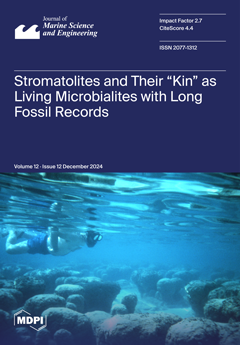The East Sea is a jointly managed maritime area of Korea, Russia, and Japan, where the frequency of strong typhoons is anticipated to increase with climate change, affecting its marine ecosystem and regional climate regulation. This study investigated the environmental and ecological impacts
[...] Read more.
The East Sea is a jointly managed maritime area of Korea, Russia, and Japan, where the frequency of strong typhoons is anticipated to increase with climate change, affecting its marine ecosystem and regional climate regulation. This study investigated the environmental and ecological impacts of summer typhoons entering the East Sea by analyzing satellite-derived chlorophyll-
a (Chl-
a) data, Argo float measurements, and ERA5 wind data. Our findings revealed that summer typhoons generally increased surface Chl-
a concentrations by 65.4%, with typhoon intensity substantially influencing this process. Weak typhoons caused marginal Chl-
a increases attributed to redistribution rather than nutrient supply, whereas normal and strong typhoons increased Chl-
a through enhanced vertical mixing and nutrient upwelling in the East Sea. Stronger typhoons notably impacted the mixed layer depth and isothermal layer depth, leading to greater Chl-
a concentrations within the strong wind radius. However, the increased Chl-
a magnitude was lower than that of other strong typhoons in other regions. The East Sea uniquely responds to typhoons with fewer upper environment changes, possibly due to a stable barrier layer limiting vertical mixing. These findings underscore the importance of continuous monitoring and integrated observational methods in order to better understand the ecological effects of typhoons, particularly as their intensity increases with climate change.
Full article





